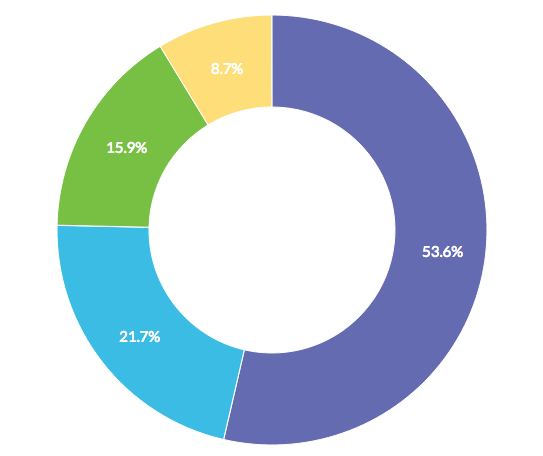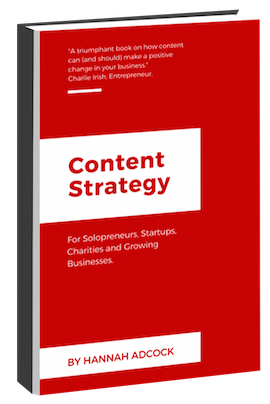Start with content strategy – not marketing
You’re a startup, solopreneur or team member of a growing business. And you know you need to grow your business. Perhaps you’ve been advised to concentrate on marketing tactics for startups, or perhaps on SEO or social media?
However, if you jump straight in to startup marketing without a content strategy you run the risk of producing a load of expensive content that offers a very poor return on investment. Why? Because if your content is not precisely focused on what your audience need, as well as on your specific business goals, then it will fail to help your business grow.
In this blog post I’ll outline a few content strategy tactics for startups that will help you focus on what content your customers need from you and how to find this out. Once you have this vital information, then customers will be magnetically drawn to your product or service because you seem to offer them precisely what they need.

What you’ll learn in this post:
- to identify your different customer groups
- to find out what content they need from you and when they need it
- to implement your customer research
Why it matters:
- If you understand who your customers are, then you can create targeted content that will persuade them to buy your product, keep buying it, and talk to their friends and followers about how much they love your product
- Companies with only a superficial knowledge of their potential customers will find it hard to market and sell to them, and will lose out to competitors
- Companies that don’t understand what their customers need are more likely to develop features and schemes that fail to engage and attract customers
This post is an early extract from my book: Content strategy for Solopreneurs, Startups and Growing Businesses. Read more about how the book can help you drive growth, engagement and investment.
If your customers are people like you then congratulations, you’re very lucky. It will be fairly easy to work out what they need. However, if your customers are not like you, or your company has a number of different types of customers, then you need to work out what they need. Don’t just guess! Then you can produce focused content that appeals to your customers rather than any old content that might not.
1.Listen to your customers to be able to sell to your customers
Create a user survey
I’m a big fan of user surveys. True, they only tell you what your actual customers want – as opposed to potential customers who might make a purchase if only you did something a little bit different. However, they can be immensely valuable in corroborating what you know, challenging your assumptions and making you smile because who knew? People like your product or service!
I helped live coding video startup Peer to Peer with a survey. They wanted to know whether people liked downloading their long videos or whether they’d prefer to stream individual chapters.
Peer to Peer started with the assumption that streaming would be better: after all, that’s the direction pioneered by successful companies like Netflix. Various tech friends and colleagues had also said streaming chapters would be better. People could watch a chapter when they had a moment, without clogging up their hard drive.
However, the survey results showed that around 75% of Peer to Peer customers wanted to download the video, giving perfectly sensible reasons like their internet speed was terrible, or that they wanted to listen on a journey where the internet could be pretty sketchy.
So, although Peer to Peer can look into streaming, because it might attract new customers (something they’ll need to validate), they probably shouldn’t kill the download option just yet.

Surveys can help you test your assumptions about what customers want
Listen to customer support
Customer support often exists in its own little world. Either because you do it all yourself, you contract it out, or you have a dedicated customer support team whose job pretty much solely involves handling customer emails and phone calls.
However, customer support can provide all kinds of useful insights into who is using your product, or thinking about using it, and whether your content is doing a good job in communicating your product.
Consider whether circulating a ‘new customer’ list within your team that will show you who is currently signing up for your product or service – and may offer some surprises.
Interview your customers
Talk to actual customers. This could simply mean that you ask recent customers why they chose you as opposed to a competitor. Ask your customer support, marketing or sales teams to keep an eye out for likely people and then send them a short email with a few questions. Or ask if they can jump on a short call. You might be surprised by what made different customers choose you. You can then assess your content based on their feedback.
If a majority of customers choose you because you provided a simple and easy solution to a problem does your website prioritise this message? Or is this message tucked underneath a message about increasing productivity that doesn’t seem to resonate as well?
If customer interviews sound a bit formal, then you can also try pouncing on people who leave comments on your blog, reviews on the App store, say something interesting on social media, or who you come across on a closed Facebook group.
Try the corridor test
One of the most straightforward ways to find out whether your content is fit for purpose is to watch someone using your site. It’s called a corridor test because all you need is a laptop and passerby – no need for a big budget or loads of time. Ask people to run through some critical tasks on your website using a laptop and/or mobile. See how they get on. You’ll soon get a good idea of any user pain points.
I remember having a browse of the website of a potential client to see how easy it would be to buy their product. Not very was the answer. From the features page I had to navigate back to the main menu where they had a ‘buy now’ button. Even one corridor test would have flagged this up as a problem. I probably wasn’t their target customer, but that didn’t matter for such a simple test of functionality.
No matter how they find you, your users almost always have very specific goals and expectations. And if your content doesn’t meet their expectations – and quickly – they will leave. Period. Kristina Halvorson and Melissa Rach
2. Create an audience research document that highlights your main findings
Collate all your research in one place so you can refer back to it and show it to other members of your team. You might also want to create a high level overview so you don’t overwhelm other team members. A high level overview of all your user research also lets you refresh your memory at a later date without having to go into all the granular details.
You might want to include charts, statistics and images to help clarify your key takeaways.
These key takeaways could include:
- age range and gender of audience
- online habits and preferences
- how they found you
- what they like best about your company
- what they dislike
- their main problems with your current content
- how they use your product or service
- how they’d describe your product or service to a friend
These are just suggestions: you’ll need to choose the takeaways that are most relevant to your business.
Don’t forget to keep researching your audience though. As your business grows you might start attracting different customer groups and you’ll need to update or refocus some of your content. If you found a user survey very helpful, for example, make it a yearly occurrence and put it in your calendar now.
3. Make your audience research actionable
Although any audience research is useful, you can make it even more helpful by ‘translating’ it into user personas. These can then be used to work out exactly what your customers need from you at what point in their journey through your content.
A persona isn’t usually based on one person: rather it is a composite of characteristics of real people/customers.
What makes up a persona?
- name
- age and gender
- job description/education level
- main problem that you can help them with
- main tasks they need to complete on your website
A sample persona
Let’s imagine I run a startup that specialises in analytics. Our main competitive advantage is that we use mathematics to power our analytics. After digging around in various channels (see user research suggestions above) I realise one of our key personas is something like this:

- Early 30s, female
- Marketing manager at major ecommerce brand
- Science and marketing background – Needs to be able to process and understand a large volume of data and derive actionable, sophisticated insights
- Needs to understand how our maths-powered AI platform can help deliver these insights and how credible we are
With this persona in mind (who I shall call Lucy), I now know what content to prioritise on our website. I’ll make sure I surface information about how we use maths early on. I’ll make sure our tone is businesslike and that we get to the point fast (Lucy is busy). I’ll show ‘social proof’ that we know what we’re doing (important clients, testimonials, relevant statistics and so on). And I’ll use images that shout ‘we’re cutting edge’ – no cute animations here.
Done well, user personas keep your team focused on those people who matter most: your audience.
4. Understand what content your different personas need from you
You’ll likely have a few different personas who use your product. For example,
-
You might have new customers and existing customers
-
Or software engineers, indie gamers and craftspeople
-
Or small businesses and multinationals
Your key messages should appeal to everyone, but you’ll also need to match different content to different audience groups. For example, say I run a subscription-based luxury car club. This is one of our personas:
- Existing customer
- 40s, male
- professional in the $50,000-$100,000 income bracket
- wants to drive exciting cars but doesn’t want the responsibility of ownership; likes the car club but doesn’t always remember to go/and has no one to go with
- needs reminders about exciting events that are happening (so being solo is no problem) and cool new cars that he can drive
So suitable content might include:
- monthly newsletter highlighting new acquisitions and events – no sales talk here. Let’s keep it informative, exciting and friendly. Customised newsletters based on his preferences is even better.
- text alerts about events he has signed up for/weather warnings that might affect driving
In contrast, a potential customer persona, even if they are broadly speaking similar (male, 40s, professional) needs very different content to persuade them to spend a large amount of money every year on membership, instead of buying a car, sharing one or relying on friends. For example:
- online content that shows how a car club works
- online content that shows how it solves customer problems (flexibility, no responsibility, social, etc.)
- online content that shows that the club is credible
- online content that offers some idea of price
- lead-generating brochure or information guide download (that captures the excitement of driving high-performance cars in a social environment)
- phone contact with a sales rep
- site visit
- online contact showing technical details that address specific questions
It’s tempting to spend a lot of time and money going after new customers, but if your business model involves people subscribing on a monthly/yearly basis to use your product then your existing customers base is very important. You want to keep them happy. It is so much easier to retain an existing customer than to attract a new one. And if you reduce churn (people leaving) and increase plan value (type of membership) and average lifetime (how long they stick around for) then your profit margins will start looking very nice indeed.
Good luck
I hope this post has given you some useful insights into why customer research is essential, as well as how you can ‘do’ customer research on a tiny budget (good for you if you have a bigger budget!).
You should see an improvement in your conversion rate, as well as in your workflow, as soon as you start precisely targeting content at your actual customers.
For further insights into how you can use content to grow your business see this post, which focuses on creating coherent and focused content across all of your site (rather than just a few seemingly ‘key’ pages). Or sign up below to be the first to hear when I publish my content strategy ebook, specifically aimed at solopreneurs, startups and growing businesses.
Content Strategy for Solopreneurs, Startups, Charities and Growing Businesses
This book will help you tackle 12 common business challenges including making sure you're reaching everyone who could be a customer, persuading people to buy from you and not a competitor, and how you can get your team to produce useful usable content. Read more about the ebook.
You'll learn
- How thinking strategically about your content will drive growth
- Practical tips on creating content strategy deliverables that will save you time and money
- How to create a content strategy for your company in 4 weeks

